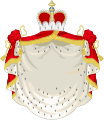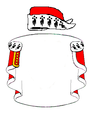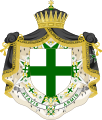Mantle and pavilion (heraldry)
This article may be expanded with text translated from the corresponding article in German. (September 2017) Click [show] for important translation instructions.
|
This article may be expanded with text translated from the corresponding article in Dutch. (September 2017) Click [show] for important translation instructions.
|
In heraldry, a mantle is a symbol of sovereign power and is generally reserved for royalty. In some cases, its use has also been granted to other nobles, in recognition of particular merits. In ordinary rendering, the mantle is usually crimson and lined with ermine.
Certain coats of arms may also display a pavilion surmounting the mantle. The pavilion is said to be the invention of the Frenchman Philip Moreau.[1]
While common in continental European heraldry, the mantle and pavilion is absent in English and Scottish heraldry.[2]
Gallery
Royal mantles
Napoleonic heraldic mantle and pavilion, topped by a Napoleonic crown
Arms of the Dutch monarch, with a mantle and pavilion
Greater arms of Sweden, featuring a purple mantle but with no pavilion
King Carl XVI Gustaf of Sweden's former arms as crown prince, with a blue mantle reflecting the Swedish princely mantle
Non-royal mantles
Mantle and princely hat of a Prince of the Holy Roman Empire
Heraldic ornaments of a duke and peer of France
Mantle and coronet of a Grandee of Spain
Historical mantle and chapeau of a Scottish feudal baron
Mantle and princely hat of the Russian nobility
Order mantles
Spanish Monarch's arms with the mantle of the Order of Charles III
Until 1931Arms of Maximilian von Fürstenberg with the mantle of the Order of the Holy Sepulchre
Arms of the Order of Saint Lazarus with mantle
See also
References
- ^ Fox-Davies, Arthur Charles (1909). A Complete Guide to Heraldry. London & Edinburgh: T.C. & E.C. Jack. p. 401.
- ^ Fox-Davies, Arthur Charles (1909). A Complete Guide to Heraldry. London & Edinburgh: T.C. & E.C. Jack. p. 400.













